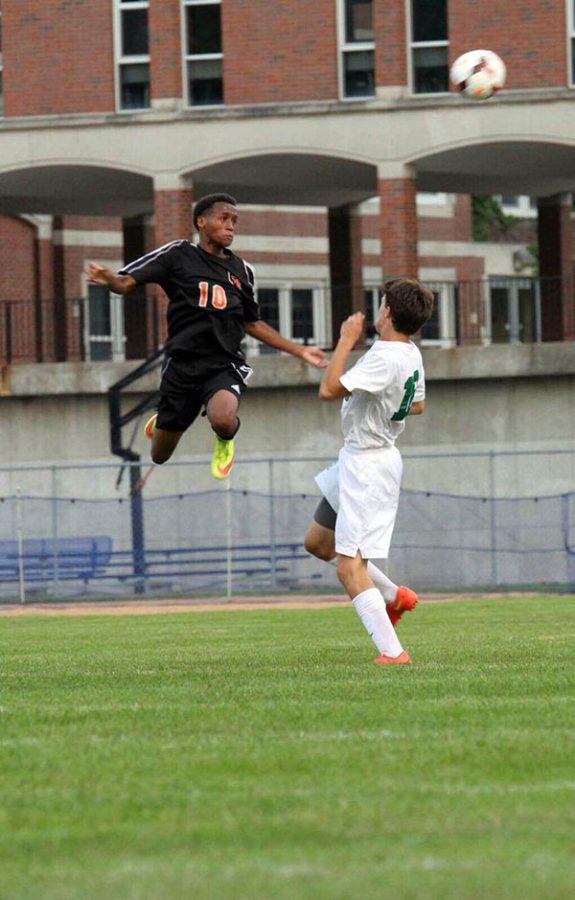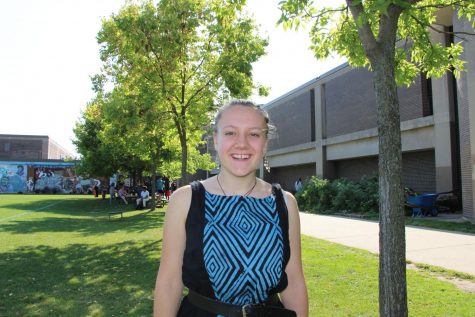Soccer bridges cultural gap for immigrants
Hamzard Abdul, born in Ethopia, performs a fantastic header for the South men’s soccer team. Abdul appreciates the differences on the team. “Just as a community it’s pretty diverse,” he said. “It’s all just different backgrounds of people. It’s sort of my favorite thing about South soccer.” Photo courtesy: Hamza Abdul
May 31, 2016
Soccer, or football as it’s known in most countries outside the US, began in 19th century England and has since exploded and become the most popular sport in the world. It is played on every continent (except Antarctica) and it a huge part of many differents countries’ cultures. This diversity of cultures is shown particularly on the South men’s soccer team, which has one of the highest percentage of immigrants playing of any sports team at South.
“Pretty much all we did [in Ethiopia] was play soccer,” said senior Hamzard Abdul, who was born in Ethiopia and has played soccer at South for four years. “I don’t think I knew any other sports but soccer.”
Soccer was also a big part of senior Erik Garcia’s family growing up. Garcia was born in Mexico and immigrated to the U.S. when he was three years old. “I remember every weekend my dad turns on the TV and watches soccer games all day long from the Mexican soccer teams,” he said. “It became like a family reunion every Saturday.”
Despite the rules and the game being the same, the community and atmosphere of soccer varies in different countries. “You have to learn by your own way, there is no people that teach you,” said senior Adnan Samir, who was also born in Ethiopia. “Over here, there are people looking for players that need more opportunity to learn soccer, but over there is no people to give you opportunity.”
Some of these differences can just be basic access to quality equipment. “[In Ethiopia], we don’t play on the grass, we play on the desert. It was hard for people when they fell and [got] hurt,” explained Samir. He went onto say that soccer players in Ethiopia “don’t use soccer shoes, they just use whatever they can.”
A common criticism of high school sports is that students will get distracted and lose interest in their school work. However, for Samir, it’s just the opposite. Soccer can, in fact, help him focus in school.“If I’m tired or depressed from classes … I just go outside and play soccer and have fun and come back again and do my work,” he said.
Often times high school sports require a lot of equipment and be inaccessible to low-income students. Garcia had similar struggles when he couldn’t play for some of the club soccer teams his friends were playing for in middle school. “The only option was to go to a local park and play there,” he said. “At that time my English was bad too … Getting informed and knowing where to go was difficult.” Many of these expensive high school sports or club team tend to be mostly made of non-immigrant white students.
However, Abdul appreciates the diversity of the men’s soccer team. “It’s great … I think it’s one of the best,” he said. “I haven’t seen this kind of team in any other schools. It’s all just different backgrounds of people. It’s sort of my favorite thing about South soccer.”
Garcia attended and played soccer for Southwest High School freshman year and found that many players, who were mostly white, had a different backgrounds from him and more opportunities, which created disparities.
“Then I compare myself, the only training I had was with older kids at the park … I saw myself as different. People grow up in different environments where they can get to different levels of the sport.” Garcia said.
This split in community made it difficult for Garcia to make friends. “I saw that big racial separation … There were only like 5 hispanics including me. It was hard to get to know people and make friends at that point,” he said. “Sophomore year I came [to South] and it’s like ‘Hey, everyone’s friendly, and I see a lot of Latino men that look like me and probably know where I come from.’ It was easier.”
Sports and other school-endorsed activities can isolate students who do not have the resources to participate but they can also bring students and welcome them into the community. Samir said that soccer helped him “gain more friends” and make connections with people who could give him rides or information. In transitioning from the Mexican leagues he’s played in middle school, Garcia experienced his first pre-game pasta party at a high school team. “I’d never done that,” he said. “That culture of going to someone’s place and eating pasta and getting together before a game, it’s an awesome thing. I’ve always liked that”.
Abdul, Samir, and Garcia have different plans for their after high school life, but they all definitely want soccer to be some part of it. Their love for soccer is what they have in common and that love is what brings in people from different parts of the world. As Garcia explained, “I lose time when I play soccer.”







Thimothy Kasozi • Jul 3, 2016 at 1:49 am
I really appreciate your work and efforts you people. Am an immigrant too , I came from eastern part of Africa, when I was about to be promoted to professional level in soccer. But when I got an opportunity to travel to America which was part of my dream . I decided to leave to America.where now I reside in illinois state. When I came I thought with what I got I will immediately get a team which is the opposite because am desperate I feel like my time for being like Messi is fading away. Am 21 on July 18th. I will just keep on workin hard as I wait for help from people like you maybe advice. I will really be grateful. Thank you.